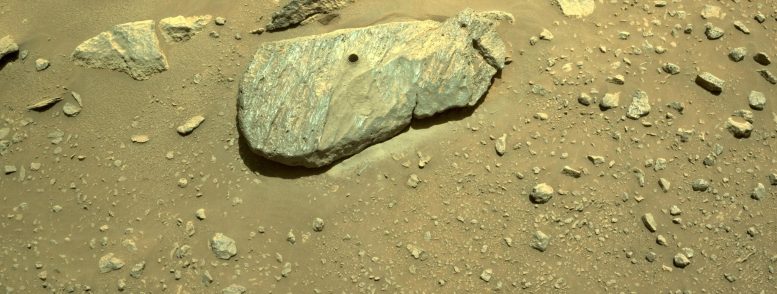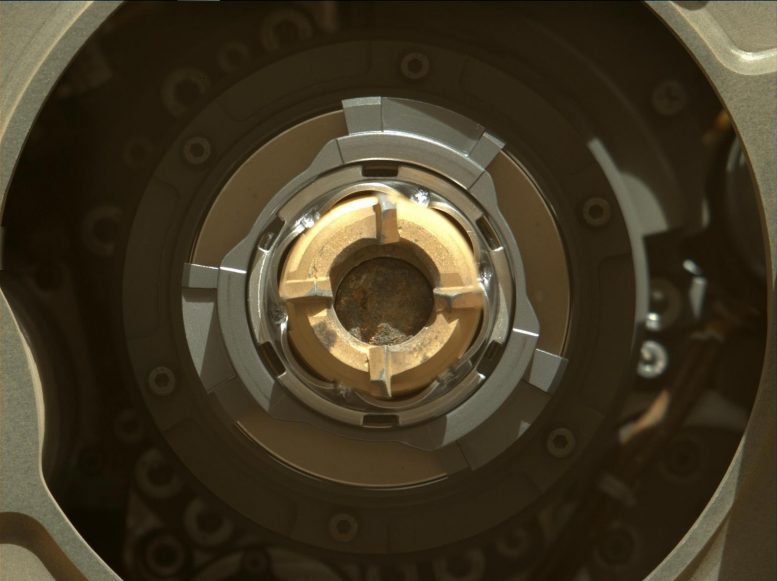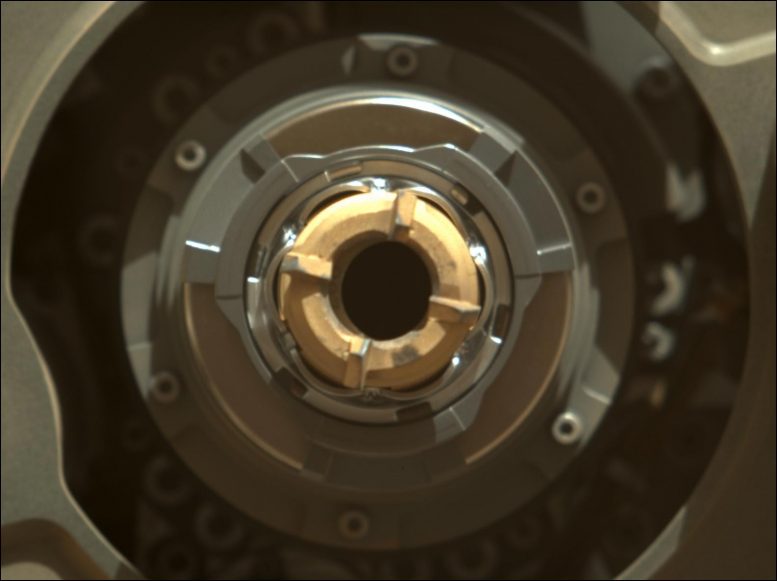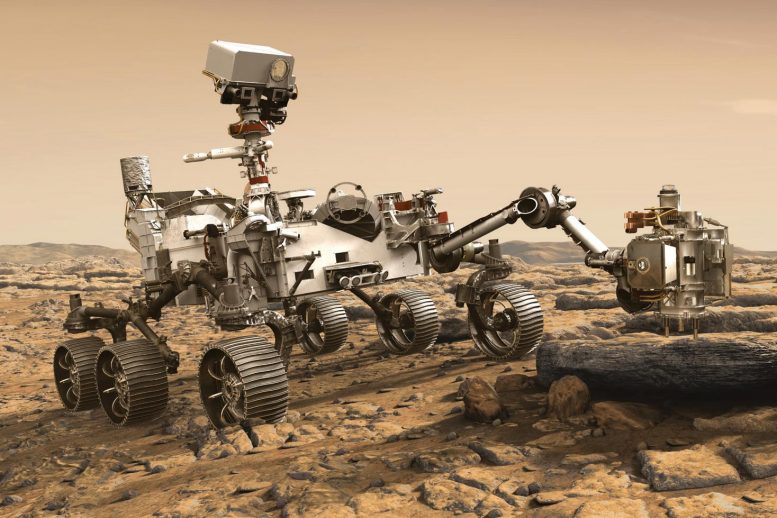NASA’s Perseverance Rover Successfully Cores Its First Mars Rock – “A Phenomenal Accomplishment!”

The drill hole from Perseverance’s second sample-collection attempt can be seen, in this composite of two images taken on September 1, 2021, by one of the Perseverance rover’s navigation cameras. Credit: NASA/JPL-Caltech
Perseverance will obtain additional imagery of the sample tube before potentially completing the process of collecting its first scientifically-selected Mars sample.
Data received late September 1 from NASA’s Perseverance rover indicate the team has achieved its goal of successfully coring a Mars rock. The initial images downlinked after the historic event show an intact sample present in the tube after coring. However, additional images taken after the arm completed sample acquisition were inconclusive due to poor sunlight conditions. Another round of images with better lighting will be taken before the sample processing continues.
Obtaining additional imagery prior to proceeding with the sealing and storing of Mars rock sample is an extra step the team opted to include based on its experience with the rover’s sampling attempt on August 5. Although the Perseverance mission team is confident that the sample is in the tube, images in optimal lighting conditions will confirm its presence.

This September 1, 2021 image from NASA’s Perseverance rover shows a sample tube with its cored-rock contents inside. Credit: NASA/JPL-Caltech/ASU/MSSS
Perseverance’s Sampling and Caching System uses a rotary-percussive drill and a hollow coring bit at the end of its 7-foot-long (2-meter-long) robotic arm to extract samples slightly thicker than a pencil. Within the bit during coring is a sample tube. After completing yesterday’s coring, Perseverance maneuvered the corer, bit, and open end of the sample tube in order to be imaged by the rover’s Mastcam-Z instrument. The target for the sample collection attempt was a briefcase-size rock belonging to a ridgeline that is more than half-a-mile (900 meters) long and contains rock outcrops and boulders.
The initial set of images from Mastcam-Z showed the end of a cored rock within the sample tube. After taking these images, the rover began a procedure called “percuss to ingest,” which vibrates the drill bit and tube for one second, five separate times. The movement is designed to clear the lip of the sample tube of any residual material. The action can also cause a sample to slide down farther into the tube. After the rover finished the percuss-to-ingest procedure, it took a second set of Mastcam-Z images. In these images, the lighting is poor, and internal portions of the sample tube are not visible.

Taken September 1, 2021 by Mastcam-Z after Perseverance’s sample-coring activities, this image shows the rover’s drill with no cored rock sample evident in the sample tube. Credit: NASA/JPL-Caltech/ASU/MSSS
“The project got its first cored rock under its belt, and that’s a phenomenal accomplishment,” said Jennifer Trosper, project manager at NASA’s Jet Propulsion Laboratory in Southern California. “The team determined a location, and selected and cored a viable and scientifically valuable rock. We did what we came to do. We will work through this small hiccup with the lighting conditions in the images and remain encouraged that there is sample in this tube.”
Commands uplinked to the rover earlier today will result in images of the corer and tube to be acquired tomorrow, September 3, at times of day on Mars when the Sun is angled in a more favorable position. Photos will also be taken after sunset to diminish point-sources of light that can saturate an image. The photos will be returned to Earth early in the morning of September 4.
If the results of this additional imaging remain inconclusive, the Perseverance team still has several options to choose from going forward, including using the Sampling and Caching System’s volume probe (located inside the rover’s chassis) as a final confirmation of the sample being in the tube.
The September 1 coring is the second time that Perseverance has employed its Sampling and Caching System since landing in Jezero Crater on February 18, 2021.
More About Perseverance
A key objective for Perseverance’s mission on Mars is astrobiology, including the search for signs of ancient microbial life. The rover will characterize the planet’s geology and past climate, pave the way for human exploration of the Red Planet, and be the first mission to collect and cache Martian rock and regolith.
Subsequent NASA missions, in cooperation with ESA, would send spacecraft to Mars to collect these sealed samples from the surface and return them to Earth for in-depth analysis.
The Mars 2020 Perseverance mission is part of NASA’s Moon to Mars exploration approach, which includes Artemis missions to the Moon that will help prepare for human exploration of the Red Planet.
JPL, which is managed for NASA by Caltech in Pasadena, California, built and manages operations of the Perseverance rover.
See the inside of a Martian rock, compliments of NASA's Perseverance rover
The NASA Perseverance rover's mission to look for signs of past life on Mars takes us deep inside a rock named "Rochette".
By Adam Rosenberg on September 4, 2021

A composite of two images showing the coring hole that Persverance drilled into the briefcase-sized rock, nicknamed "Rochette". Credit: NASA/JPL-Caltech
One of the primary missions for NASA's Mars rover, Perseverance, is looking for evidence of past life. Some of that evidence is hidden away deep inside of Martian rocks.
That's what led Perseverance to drill into one particular briefcase-sized rock and, for the first time during its still-young mission, collect a core sample. Images and data that NASA received on Sept. 1 confirmed that the rover's first coring attempt was (probably) a success.
There's a whole process here that starts with a more superficial look at the Mars surface. Perseverance is fitted with several tools for interacting with the environment, including a Rock Abrasion Tool (RAT), which is "a high-speed grinder with brushes to remove that weathered outer layer of rock and clear away dust," and a Gaseous Dust Removal Tool (GDRT) that, as its name suggests, clears away the dust at the site of the abrasion.
This first part of the process gives the rover an opportunity to use some other built-in instruments to examine the targeted rock even more closely. The data gathered from there helps NASA engineers decide if it's worth moving on to the next step of trying to obtain a core sample.
This whole process unfolded earlier in August, which led in turn to Perseverance's first attempt to core a Martian rock. Things didn't go according to plan that time, as NASA explained in an Aug. 11 post.
While the rover's seven-foot drill successfully bored its way into the rock and seemed to come away with a sample, images beamed back to Earth showed an empty storage tube. Unfortunately, that revelation occurred only after the tube was sealed and stored for future retrieval. It turned out that the rock itself wasn't the best candidate for coring.
For the latest attempt, which appears to have been a success, the NASA team back on Earth learned from their earlier experiences. This time, they used one of the Perseverance rover's onboard cameras, Mastcam-Z, to snap an image of the sample tube — or at least, the top of it — before sealing it away for storage.
The first look is encouraging, with actual rock clearly visible in the open end of the sample tube. But that's only the first step before storage. Once a sample is collected, the rover kicks off a procedure called "percuss to ingest" which rattles the sample tube five times in brief, one-second bursts. The goal is to clear any excess residue from the lip of the tube, but that shaking can also send collected material deeper down.
That appears to be what happened here. While NASA's first shot of the tube's open end clearly shows there's something inside, a second shot, captured after the "percuss to ingest" process, shows only a dark space.
Again heeding the lessons of the first coring attempt, NASA isn't quite ready to call this coring operation a total success. Before the tube gets sealed off for storage, the Mastcam-Z will go to work once again "at times of day on Mars when the Sun is angled in a more favorable position." The hope is that a new crop of images taken in different light will offer a clearer look into the sample tube.
No one's expecting failure at this point, however.
SEE ALSO: Mars rover sky watches, and spots a weird Martian moon
"The project got its first cored rock under its belt, and that’s a phenomenal accomplishment," said Jennifer Trosper, project manager at NASA's Jet Propulsion Laboratory (that's the team in charge of the Perseverance project). She added: "We did what we came to do. We will work through this small hiccup with the lighting conditions in the images and remain encouraged that there is sample in this tube."
It's going to be some time before the samples collected by Perseverance are actually safely ensconced on Earth. If all goes according to plan, the rover's bounty will arrive here sometime in 2031 at the end of a three-stage "Mars Sample Return" (MSR) mission.

No comments:
Post a Comment